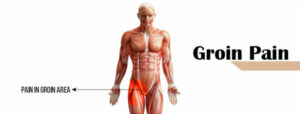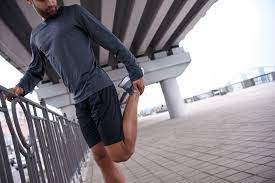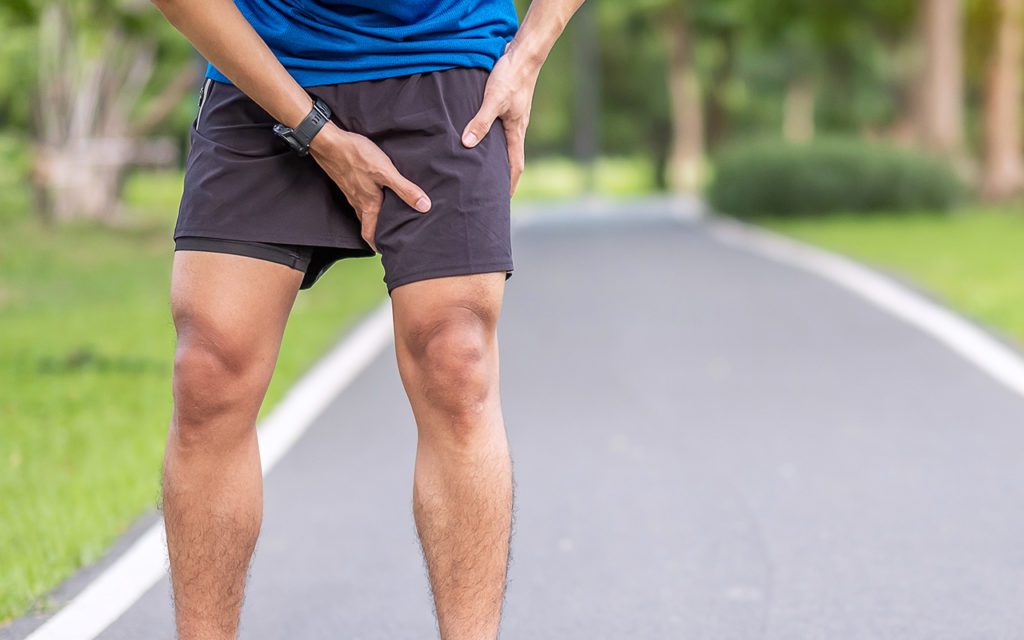Do you have a sharp pain in your groin area? Are you having difficulty walking or standing up? If so, you may have a strained groin. This is a very common injury, and it can be caused by many different things. In this blog post, we will discuss the symptoms, causes, and treatments for a strained groin. We will also provide tips on how to prevent this injury from happening in the future.
Contents
What Is Strained Groin?
 A strained groin is a condition that results when the muscles of the inner thigh are overloaded and become damaged. The damage can be either to the muscle tissue itself (a muscle strain) or to the tendons that attach the muscles to the bone (a tendon strain). Both types of strains can occur simultaneously.
A strained groin is a condition that results when the muscles of the inner thigh are overloaded and become damaged. The damage can be either to the muscle tissue itself (a muscle strain) or to the tendons that attach the muscles to the bone (a tendon strain). Both types of strains can occur simultaneously.
This condition is a common injury in athletes, particularly those who participate in sports that involve running and jumping. It is also seen in people who do not participate in sports but who have a sudden change in activity level, such as when they start a new exercise program.
According to studies, this injury represents about 5 to 8 percent of all sports injuries. It is more common in men than in women and usually occurs in people between the ages of 20 and 50. If you are a man over the age of 50, you have a higher risk for this injury if you have had previous groin injuries.
Therefore, if you are having symptoms that you think may be due to a strained groin, it is important to see your doctor so that the cause can be properly diagnosed and treated.
How Does It Feel Like?
It is not easy to put a finger on the symptoms of a groin strain because the pain can vary widely from person to person. For some, the pain might be sharp and severe while for others, it might be more of a dull ache. The intensity of the pain will also depend on how badly the muscle is strained.
In most cases, however, you will feel pain in the following areas:
- Inside of the thigh, near the groin
- Outside of the thigh, near the hip
- In the lower abdomen
The pain might get worse when you move your leg or when you put weight on it. You might also feel a burning sensation or a feeling of numbness in the affected area. If you have a severe groin strain, you might feel a popping sensation when the injury occurs.
What Causes Strained Groin?
 There are various causes of a strained groin. Some of these are:
There are various causes of a strained groin. Some of these are:
Overstretching or tearing the muscle
It is one of the most common causes of a strained groin. When you make an abrupt movement or overstretch your muscles, it can tear the muscle fibers and lead to a strain. For example, if you suddenly twist your leg while playing a sport, it can lead to a strained groin. This is very common with athletes.
Direct impact or trauma
In some cases, a traumatic event such as a fall, car accident, or hard tackle during a sports game can cause a groin strain. This type of injury is more common in contact sports, such as football and hockey. For instance, a football player may suffer a groin strain while making a tackle.
Weak muscles
If a person has sudden, severe pain in the groin area, it may be due to a muscle strain. The muscles that attach to the bone in this area are called the adductor muscles. These muscles help move the legs inward toward the midline of the body. A weak muscle is more prone to injury so you have a greater risk of developing a groin strain if your adductor muscles are weak.
Tight muscles
A tight muscle can also cause a groin strain. The muscles in the area include the adductor muscles, which are responsible for bringing your legs together, and the sartorius muscle, which runs from your hip to your knee. If these muscles are tight, they can put extra strain on the groin area and lead to a strain.
Repetitive motions
If a person is engaged in a sport or other activity that involves repetitive motions, they may be more likely to develop a strained groin. These motions can put a strain on the muscles and tendons in the groin area, making them more susceptible to injury.
All in all, these are a few common causes of a strained groin. However, it is important to note that this is not an exhaustive list. There are other potential causes of a strained groin that have not been mentioned here. If you think you may have a strained groin, it is best to consult with a medical professional to get a proper diagnosis.
How To Diagnose Strained Groin?
 While the diagnosis of a strained groin is generally made based on the symptoms and a physical examination, there are some tests that can be performed to confirm the diagnosis.
While the diagnosis of a strained groin is generally made based on the symptoms and a physical examination, there are some tests that can be performed to confirm the diagnosis.
These tests may include:
- MRI or ultrasound: These imaging tests can help to rule out other causes of groin pain, such as a sports hernia or a muscle tear.
- X-ray: An X-ray may be performed to rule out other causes of groin pain, such as a stress fracture.
- Nerve conduction studies: These tests may be performed if your doctor suspects you have a nerve injury.
- Blood tests: Blood tests may be ordered if your doctor suspects you have an infection.
These tests can confirm the diagnosis of a strained groin and help to rule out other potential causes of your symptoms. Always remember that an accurate diagnosis is essential for proper treatment. So, do not hesitate to see your doctor if you are experiencing groin pain.
What Are The Treatments For Strained Groin?
The treatment of a strained groin will depend on the severity of your injury. There are different types of strains, with each one requiring a different method of treatment:
Mild strains
For mild groin strains, the RICE method (rest, ice, compression, and elevation) is usually recommended. You should also avoid any activities that may aggravate your symptoms. If pain persists, over-the-counter pain medication may be recommended.
The RICE method is about giving your body time to heal. For example, the first is rest. This means taking a break from any activities that may put a strain on your groin. Ice is to help reduce pain and swelling. Compression, such as with an elastic bandage, can also help with swelling. And finally, elevation helps reduce swelling by keeping the affected area above the level of your heart.
But, depending on the severity of your strain, you might not be able to put any weight on your leg for a few days. This can make it difficult to carry out normal activities or even get around.
Severe strain
 If you have a severe groin strain, you may feel a pop or tearing sensation. There are some other options to treat this condition. Some of the treatments are:
If you have a severe groin strain, you may feel a pop or tearing sensation. There are some other options to treat this condition. Some of the treatments are:
- Surgery: It is rarely needed but may be recommended if the tendon is completely torn. The surgery works by reattaching the tendon to the bone.
- Physical therapy: This is often used to help improve range of motion and strength. The therapist may also use techniques to decrease pain and swelling.
- Immobilization: This is a type of treatment that is used to allow the injury to heal. It may be in the form of a splint, sling, or cast.
- Electrical stimulation: In some cases, electrical stimulation may be used to help reduce pain. It works by sending electrical impulses to the injured area.
- Ultrasound: This is a type of therapy that uses sound waves to help reduce pain and inflammation. For example, ultrasound therapy can help with pain, inflammation, and cramping caused by a strained groin.
These are some of the most common treatments for a strained groin. If you have this condition, be sure to talk to your doctor about the best treatment for you. The treatment options for a strained groin will vary depending on the severity of the injury.
Moreover, you should always remember that a strained groin is a serious injury. If you think you have this condition, it is important to see a doctor right away. This is especially true if you are having any of the major symptoms. With the right approach, you can overcome this condition.
Can It be Prevented?
Prevention is possible in some cases. For example, if you are an athlete, you can take steps to prevent a groin strain by stretching and warming up properly before participating in your sport. If you have had a previous groin strain, you can try to prevent another one by:
- Wearing supportive devices, such as an athletic supporter with a cup for men or a pelvic protector for women
- Avoiding sudden increases in training intensity or duration
- Using proper technique when participating in your sport
- Cross-training to reduce the risk of overuse injuries
- Maintaining a healthy weight
If you are not an athlete, you can also help prevent a groin strain by maintaining a healthy weight and avoiding sudden increases in activity levels. You should also be careful when lifting heavy objects, as this can put additional strain on the muscles in your groin area.
It is important to understand that prevention can only do so much. Even with proper precautions, a groin strain can still occur. If you do experience a groin strain, it is important to seek treatment right away to promote healing and reduce your risk of further injury.
Conclusion
To conclude, a strained groin is a condition that can be caused by a variety of things, ranging from simple overuse to more serious underlying conditions. However, regardless of the cause, there are treatments available that can help to ease the pain and discomfort associated with this condition.
If you think that you may be suffering from a strained groin, be sure to speak to your doctor so that they can properly diagnose and treat the condition. With the right treatment, you can soon be on your way to recovery.
Physical Therapy help patients recover from pain. If you’re experiencing Back pain, Shoulder pain, Knee pain, Neck pain, Elbow pain, Hip pain, or Arthritis pain, a physical therapist at MantraCare can help: Book a physiotherapy session.


